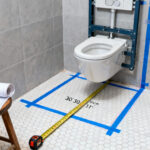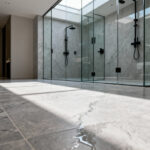The kitchen is more than just a place to cook—it’s where life happens. From morning coffee rituals to late-night conversations, this space witnesses countless moments that define our daily experience. When a kitchen lacks personality or feels outdated, even the simplest cooking tasks can feel uninspiring.
I’ve spent years helping homeowners understand how thoughtful design choices can dramatically change not just how a kitchen looks, but how it feels to be in it. The right lighting, smart storage solutions, and carefully selected decorative elements can transform a purely functional space into the true heart of your home. These 24 kitchen decorating inspiration ideas range from simple weekend projects to more significant updates, all designed to create a kitchen that’s as beautiful as it is practical.
1. Choose the Perfect Color Palette
Selecting a color palette for your kitchen sets the foundation for everything else. Begin by considering the fixed elements you can’t or don’t want to change—flooring, countertops, or major appliances. These existing features often have inherent undertones that can guide your color direction. Think about the feeling you want to create: energetic and vibrant, calm and serene, or warm and inviting. Natural light plays a crucial role too, as it significantly alters how colors appear throughout the day.
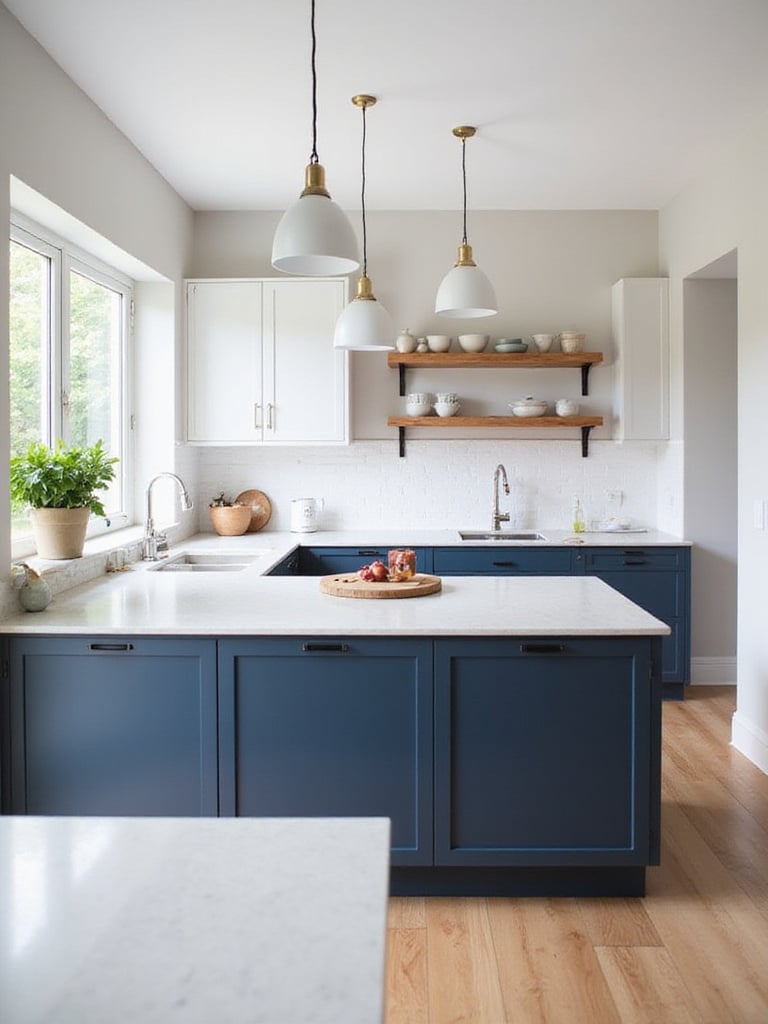
Popular kitchen color combinations include timeless white with warm wood tones, sophisticated navy with crisp white, and the increasingly popular two-tone approach with different colors for upper and lower cabinets. Remember that lighting dramatically affects color perception—warm bulbs (2700K-3000K) make colors feel cozier but might slightly yellow cool tones, while cooler bulbs (4000K+) create a crisper appearance but might feel less inviting.
The magic of this piece lies in its ability to set the stage for your entire kitchen design. Once you’ve established your color foundation, you can turn your attention to surfaces that offer incredible decorative potential, like the backsplash.
2. Elevate Your Backsplash
A Kitchen Backsplash serves dual purposes that make it worth careful consideration. Functionally, it protects walls from moisture, grease splatters, and food stains. Aesthetically, it often becomes one of the first things people notice when entering your kitchen—a canvas for expressing your style through color, texture, and pattern.
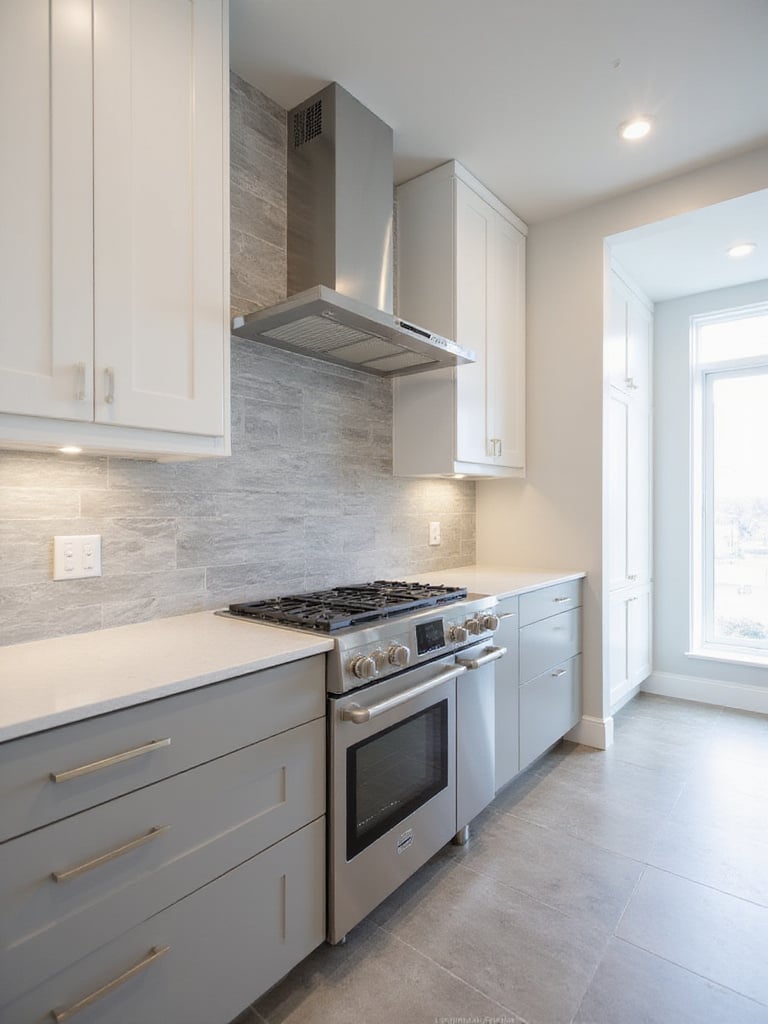
Materials range from classic subway tile and dramatic natural stone to contemporary glass and industrial metal. Each brings different benefits in terms of maintenance, durability, and visual impact. While traditional backsplashes extend just 4 inches above the counter, today’s designs often reach all the way to upper cabinets or even to the ceiling, creating a more dramatic and finished look that protects more wall surface and provides a larger canvas for your chosen material.
The designer’s attention to detail shows in how a backsplash can transform from purely functional to a stunning focal point. With your walls protected and styled, it’s time to consider the smaller details that make a remarkable difference: your cabinet hardware.
3. Update Cabinet Hardware
Changing cabinet hardware is perhaps the most accessible kitchen transformation you can make. This relatively quick DIY project doesn’t require major renovations but can dramatically shift the style of your cabinets and, by extension, the entire kitchen. New knobs, pulls, or handles introduce fresh finishes, textures, or shapes that instantly update an outdated look—like adding jewelry to complete an outfit.
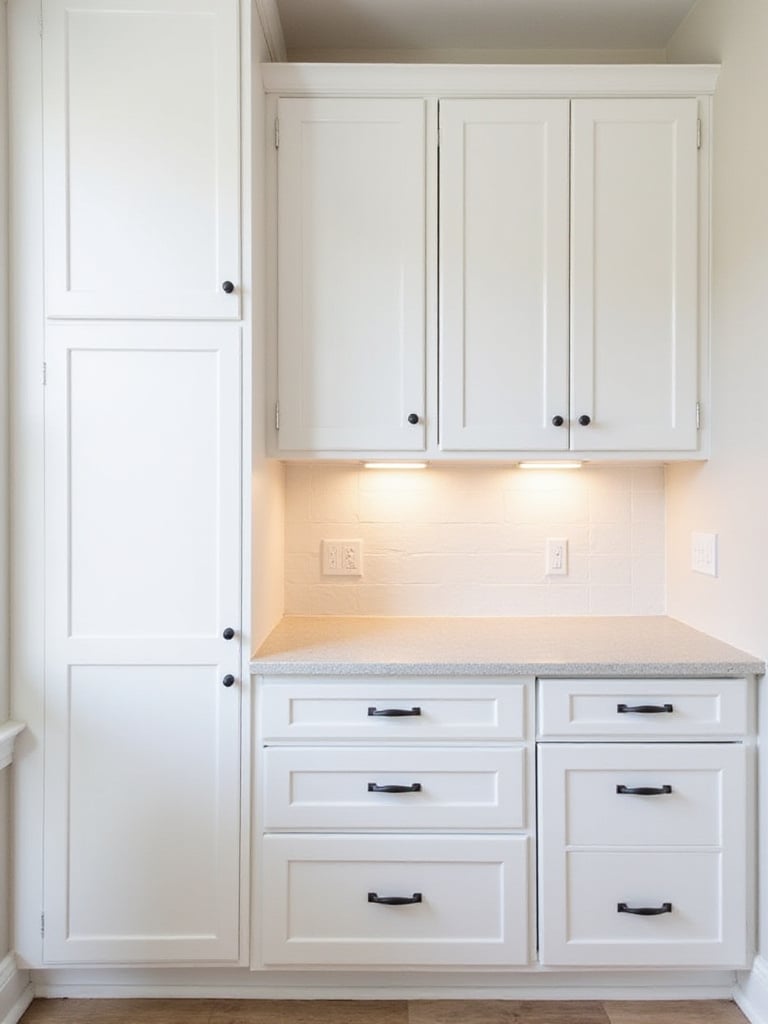
The hardware you choose significantly impacts your kitchen’s style. Knobs (single-point fasteners) offer a classic, versatile look in various shapes and materials. Pulls (requiring two mounting points) come in styles ranging from modern bar pulls to vintage cup pulls, often providing better grip for drawers. For sizing, a common guideline suggests pulls should be roughly one-third the width of the drawer or door face, while knobs should be proportionate to the cabinet. Placement consistency is key—use a template to ensure uniform installation across all cabinets.
What makes this design special is the way small details can completely transform the feel of your kitchen. Once your cabinet hardware is updated, look up and consider how statement lighting could add drama and functionality to your space.
4. Install Statement Lighting
Statement lighting refers to fixtures designed to be focal points—not just functional light sources. These eye-catching elements draw attention while contributing significantly to your kitchen’s style and ambiance. Whether it’s oversized pendants above an island, a dramatic chandelier in an eat-in area, or unique sculptural fixtures, statement lighting helps define specific zones while adding personality and character.
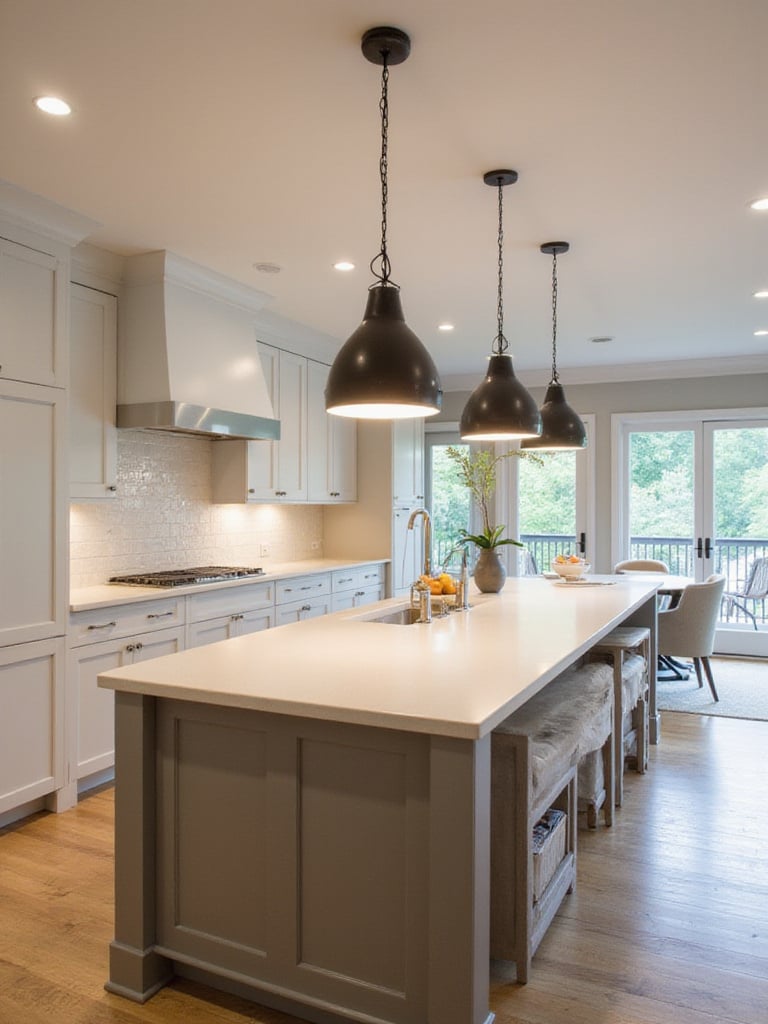
The most popular location for statement lighting is above a kitchen island or peninsula, where large pendants or a series of smaller ones create impact. Another excellent spot is above a dining table or in an eat-in nook, where a chandelier can establish a defined dining zone. When selecting the right size, consider proportions carefully—for pendants over an island, think about the island’s length; for chandeliers in dining areas, aim for a diameter roughly half to two-thirds the width of the table.
The unexpected environmental benefit comes from how well-designed lighting can reduce energy usage while creating the perfect ambiance. Moving from overhead drama, consider a design element that opens up the space and offers versatile display opportunities: open shelving.
5. Incorporate Open Shelving
Open shelving has gained tremendous popularity in kitchen decorating inspiration trends for good reason. Aesthetically, it makes kitchens feel more spacious and airy, especially in smaller rooms. It provides opportunities to display beautiful dishware, cookbooks, plants, and decorative items that add personality. Practically, it offers easy access to frequently used items and can be more budget-friendly than traditional upper cabinets.

Popular materials for open shelves include solid wood for warmth and character, metal for industrial appeal, and glass for contemporary elegance. While stylish, open shelving does require commitment to organization and regular cleaning, as items collect dust and cooking residue more readily than behind cabinet doors. Weight capacity is also a consideration—shelves must be installed securely into wall studs to support the weight of dishes and other items.
The versatility reveals itself when you pair this practical storage solution with thoughtful styling. Just as open shelves offer display space, your kitchen island itself is a prime area for both function and beautiful decoration.
6. Style Your Kitchen Island
Your kitchen island often serves as the command center of the entire space—a multifunctional hub for food prep, dining, entertaining, and storage. As the natural focal point, how you style this prominent feature significantly impacts the overall look and feel of your kitchen. Thoughtful styling enhances functionality while adding personality that ties together your design elements.
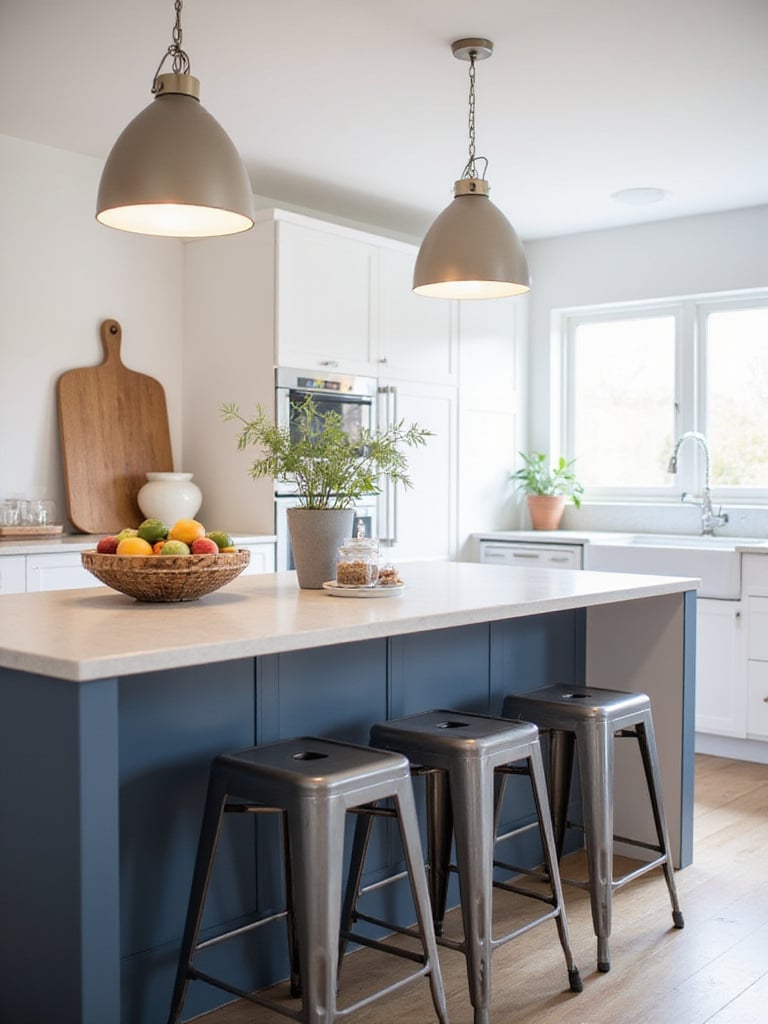
Consider several key elements when styling your island: comfortable, correctly-sized seating that complements your kitchen’s style; appropriate lighting that provides both task illumination and visual interest; and carefully selected decorative elements like fruit bowls, cutting boards, or plants that remain proportional to the island’s size. For maximum functionality and beauty, assess how you primarily use the space—prep-heavy islands should keep surfaces relatively clear, while islands used primarily for dining might incorporate a low-profile centerpiece.
The artisans’ commitment to environmental practices means your island can be both beautiful and sustainable. The island’s countertop is a major visual element; let’s explore how to make it truly eye-catching.
7. Select Eye-Catching Countertops
An eye-catching countertop serves as a focal point through its unique material, bold color, dramatic pattern, or distinctive texture. The right countertop instantly elevates your kitchen’s aesthetic, adding personality, luxury, or modern edge while tying together different design elements. It can contrast beautifully with cabinetry or introduce a striking pattern that transforms a standard kitchen into a statement space.
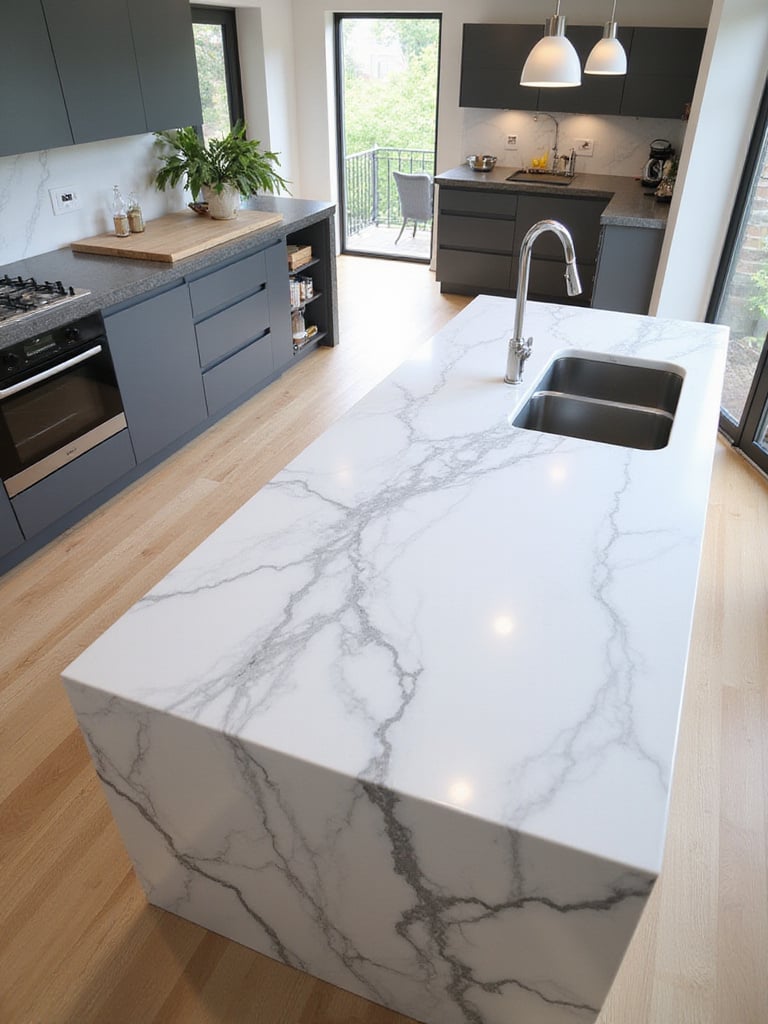
Several materials excel at creating visual impact. Natural stones like granite and marble offer unique, organic patterns and veining that can be incredibly dramatic. Engineered quartz provides consistent or bold patterns in a wide range of colors while offering practical benefits. Other options include custom-colored concrete, recycled glass with unique color flecks, or even luxury materials like lava stone or semi-precious stones. When selecting, balance visual impact with practicality—consider your cooking habits, maintenance preferences, and budget constraints.
The interplay between the colors creates a foundation for your kitchen’s entire design scheme. Moving from the horizontal plane of the countertop, let’s consider the impact of the surface below your feet—the flooring that ties everything together.
8. Refresh Your Flooring
Kitchen flooring must balance beauty with exceptional durability and practical function. Several materials have earned their popularity through this balance: ceramic and porcelain tile offer excellent water and stain resistance with endless style options; hardwood brings timeless warmth despite needing more care with spills; luxury vinyl plank (LVP) provides realistic wood or stone looks with superior water resistance; and concrete delivers modern industrial appeal with proper sealing.
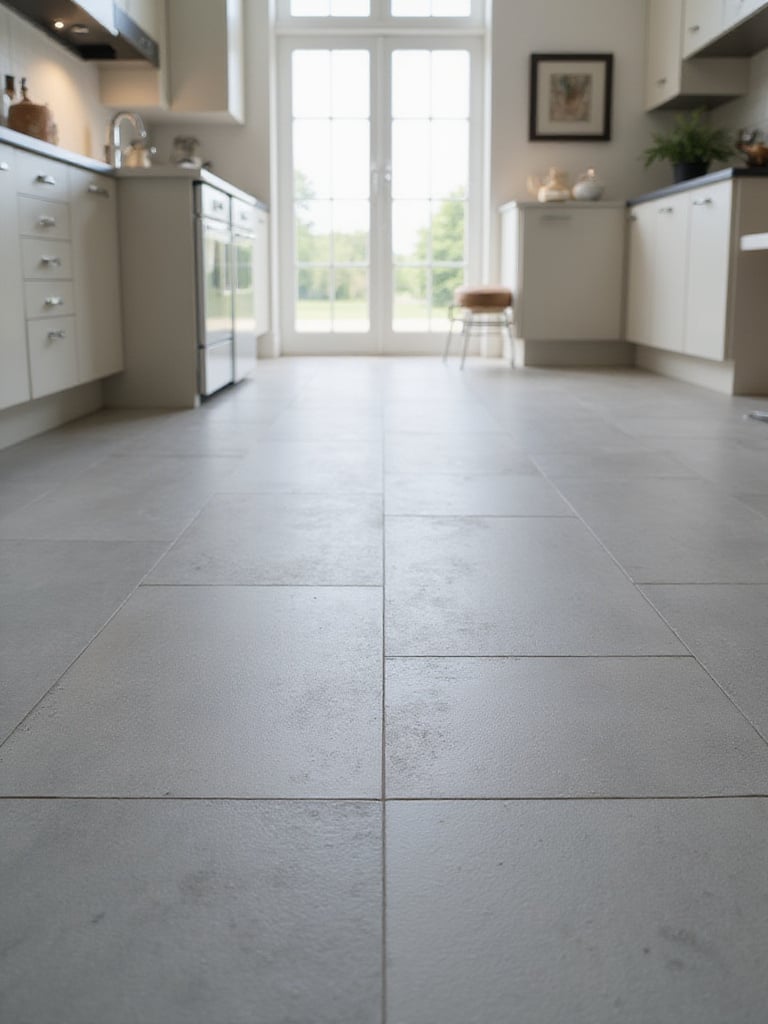
When selecting new flooring, prioritize water resistance and durability first, as kitchens face spills, dropped items, and constant foot traffic. Consider maintenance requirements, comfort underfoot (especially important if you spend hours cooking), budget constraints, and how the flooring will complement existing cabinetry, countertops, and your overall kitchen style. For budget-friendly refreshes without full replacement, consider refinishing existing hardwood, sealing concrete, using tile paint kits, or adding quality area rugs to define zones.
Running your hand across this material reveals the tactile quality that makes flooring such an important part of kitchen decorating inspiration. Beyond the fixed elements like floors and counters, consider how your everyday appliances can contribute to your decor.
9. Accessorize with Appliances
Kitchen appliances have evolved from purely functional tools to statement pieces that can significantly enhance your decor. By thoughtfully selecting appliances that complement or contrast with your kitchen’s aesthetic, you transform utilitarian items into decorative elements. A vibrant stand mixer adds a pop of color to a neutral countertop, while a sleek espresso machine becomes a conversation piece that reflects your personal style.

Small countertop appliances offer the most flexibility for decorative impact. Stand mixers, blenders, toasters, kettles, and coffee makers come in countless colors and styles—from retro-inspired pastels to sleek stainless steel or matte black finishes. Even larger appliances like refrigerators and ranges can be chosen in distinctive finishes that make design statements. The key is selecting pieces whose design aligns with your desired aesthetic, whether it’s a vintage-inspired kettle for farmhouse charm or a minimalist chrome toaster for contemporary appeal.
The unexpected pairing that always works is functional appliances that double as decorative elements. Just as smaller appliances can enhance your decor, the highly-functional sink and faucet also offer significant style potential.
10. Upgrade Your Sink and Faucet
The kitchen sink and faucet are among the most frequently used fixtures in your entire home. Upgrading these workhorses provides both fresh aesthetics and improved functionality through features like pull-down sprays, deeper basins, or touchless technology. As prominent focal points, they tie together your kitchen design whether you’re creating sleek contemporary appeal, rustic farmhouse charm, or classic elegance.
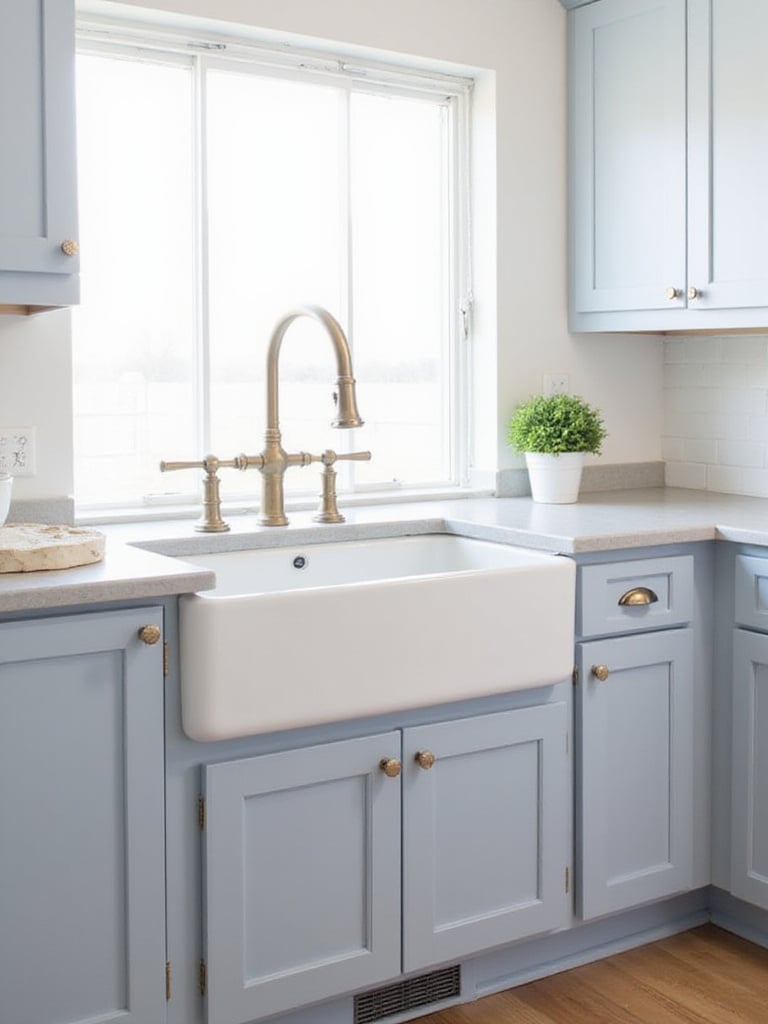
Popular sink styles include the dramatic farmhouse/apron-front sink (often in fireclay or stainless steel), seamless undermount sinks that integrate perfectly with countertops, and classic top-mount options for easier installation. Materials range from durable stainless steel and enameled cast iron to composite granite and natural stone. For faucets, styles include highly functional pull-down sprays, traditional bridge designs, and innovative touchless models, available in finishes from classic chrome and brushed nickel to trendy matte black and warm brass.
When clients ask us about balancing style with comfort, I often suggest focusing on these hardworking elements that blend form and function. With key fixtures addressed, consider the empty wall spaces as canvases for personality and style.
11. Add Wall Art or Decor
Kitchen wall art and decor breathe life into what might otherwise be a purely utilitarian space. When selecting pieces, prioritize durability and ease of cleaning due to the kitchen’s unique environment. Excellent options include framed prints behind glass, metal signs that wipe clean easily, ceramic decorative tiles, chalkboard areas for notes or menus, and durable wallpapers designed specifically for kitchens.
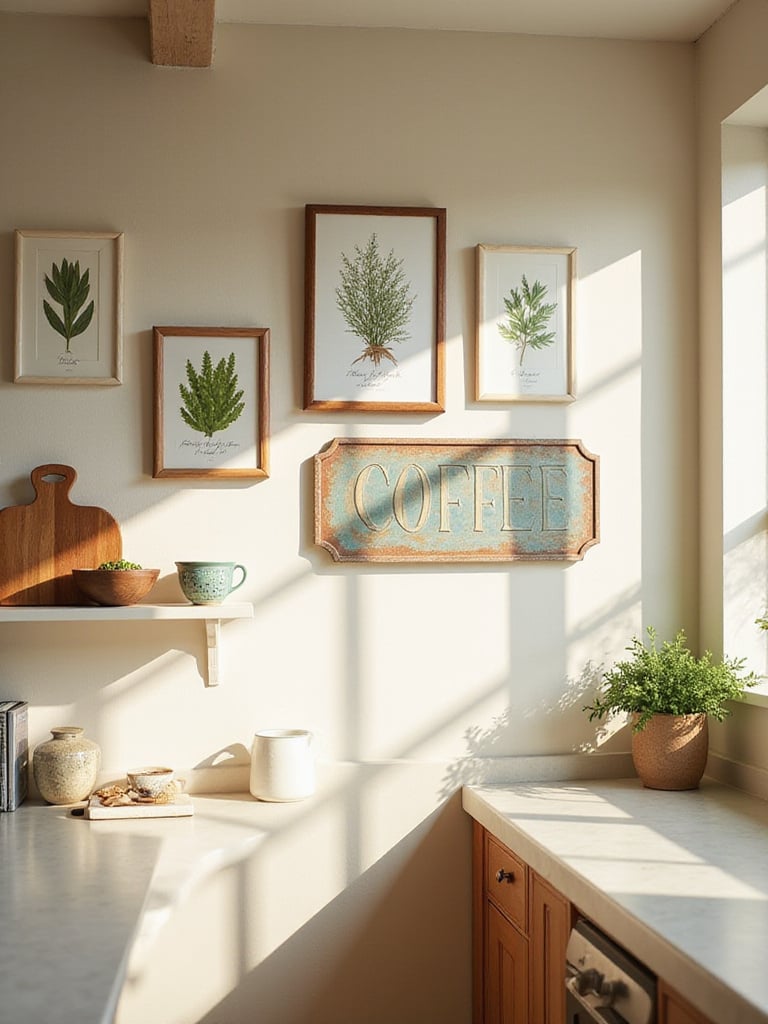
Ideal locations include empty wall spaces above countertops or cabinets, breakfast nook walls, prominent feature walls, or smaller nooks away from direct heat and moisture. Open shelving provides additional opportunities to display a mix of decorative and functional items. The impact of thoughtfully chosen art transforms the kitchen beyond a workspace into a room with personality and style, introducing color, pattern, and texture while reinforcing your design theme.
The inspiration for this collection struck when I realized how much time we spend in our kitchens and how art can make that time more joyful. Speaking of adding life to the kitchen, introducing greenery with plants is a simple yet powerful way to enhance the space.
12. Bring in Greenery with Plants
Adding plants to your kitchen offers multiple benefits beyond mere decoration. They improve air quality by filtering common indoor pollutants from cooking and cleaning products. Plants boost mood, reduce stress, and create a more calming atmosphere. Many kitchen-friendly plants, like herbs, provide the practical benefit of fresh ingredients readily available while cooking, creating a beautiful connection between decoration and function.
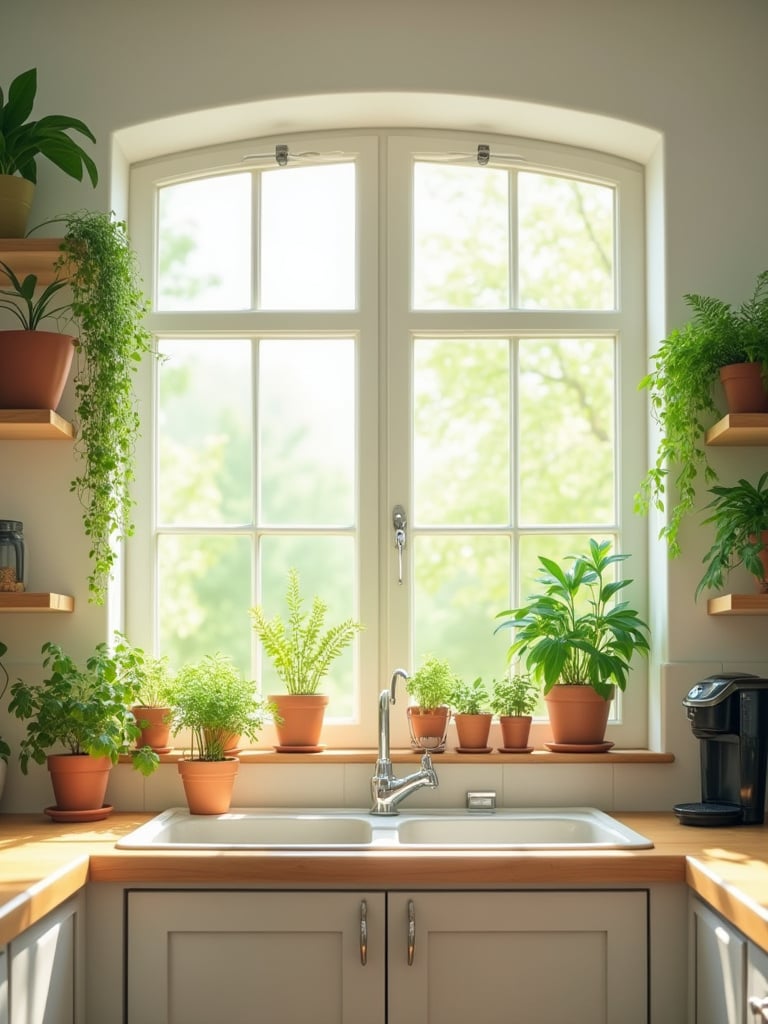
The best plants for kitchens depend on your specific light conditions and humidity levels. Sunny windowsills welcome herbs like basil, rosemary, and mint, as well as succulents. Areas with bright, indirect light support easy-care options like Pothos, Spider Plants, and Snake Plants. Kitchen humidity (especially near sinks) benefits moisture-loving plants like ferns, provided they receive adequate light. Display options abound—windowsills for sun-lovers, open shelving for trailing varieties, countertop corners for small arrangements, and hanging planters to utilize vertical space.
The emotional response this evokes begins with the simple joy of watching something grow in your care. Just as plants soften hard edges, textiles are essential for adding warmth and comfort to kitchen decorating inspiration.
13. Layer with Textiles
Textiles are crucial in kitchens because they soften the hard surfaces that dominate the space. Unlike stone, metal, and tile, fabrics introduce texture, color, and pattern in a way that feels inviting and lived-in. Without the visual and tactile warmth textiles provide, a kitchen can feel sterile and unwelcoming. They offer an easy, relatively inexpensive way to inject personality and make the functional heart of your home feel cozy.
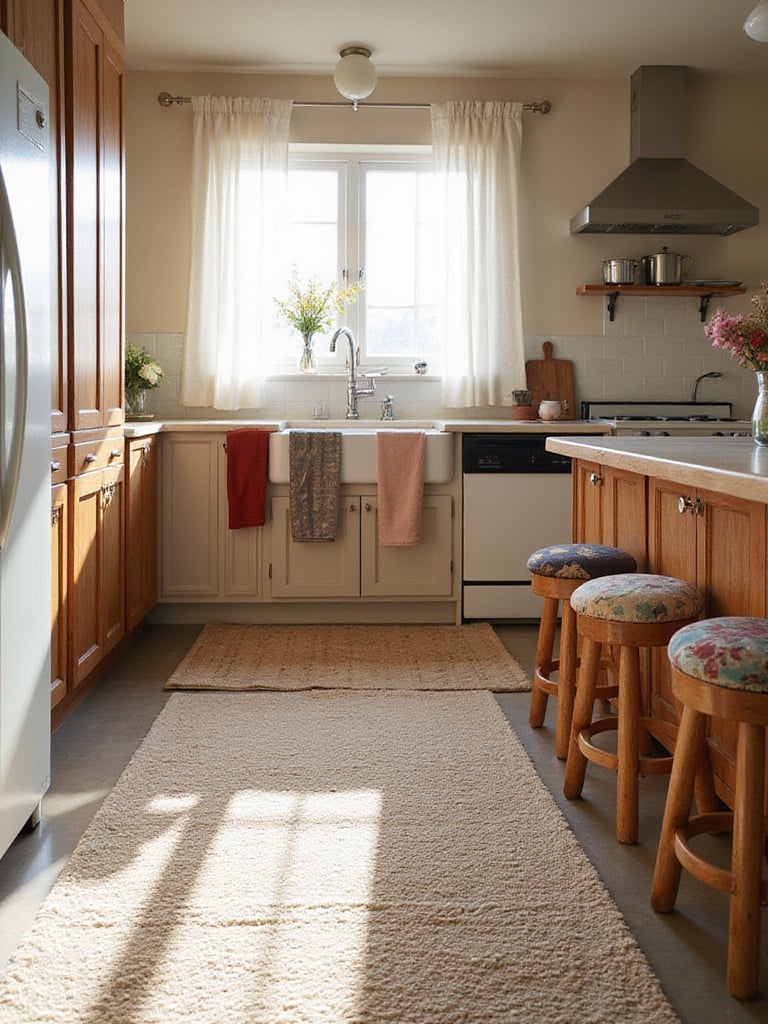
The main types of textiles suitable for layering include:
- Rugs & Runners: Add warmth, comfort underfoot, and define zones
- Window Treatments: Curtains, valances, or Roman blinds add softness and control light
- Dish Towels & Cloths: Functional items that introduce color and pattern
- Seat Cushions: Add comfort and style to banquettes, bar stools, or dining chairs
- Table Linens: Tablecloths, runners, and placemats for islands or dining nooks
The craftsmanship reveals itself in details like the way a hand-loomed kitchen runner feels underfoot or how sunlight filters through a perfectly chosen window treatment. Building on the idea of adding comfort, creating a dedicated seating nook transforms a kitchen from purely functional to a space for relaxation and connection.
14. Create a Cozy Seating Nook
Adding a seating nook to your kitchen creates a dedicated spot for informal meals, coffee breaks, or gathering with family and friends. It maximizes seating in smaller kitchens where a full dining table might not fit and often utilizes underutilized spaces like corners or bay windows. A well-designed nook adds a layer of coziness that makes your kitchen feel more inviting, and many designs incorporate hidden storage under bench seats for added functionality.
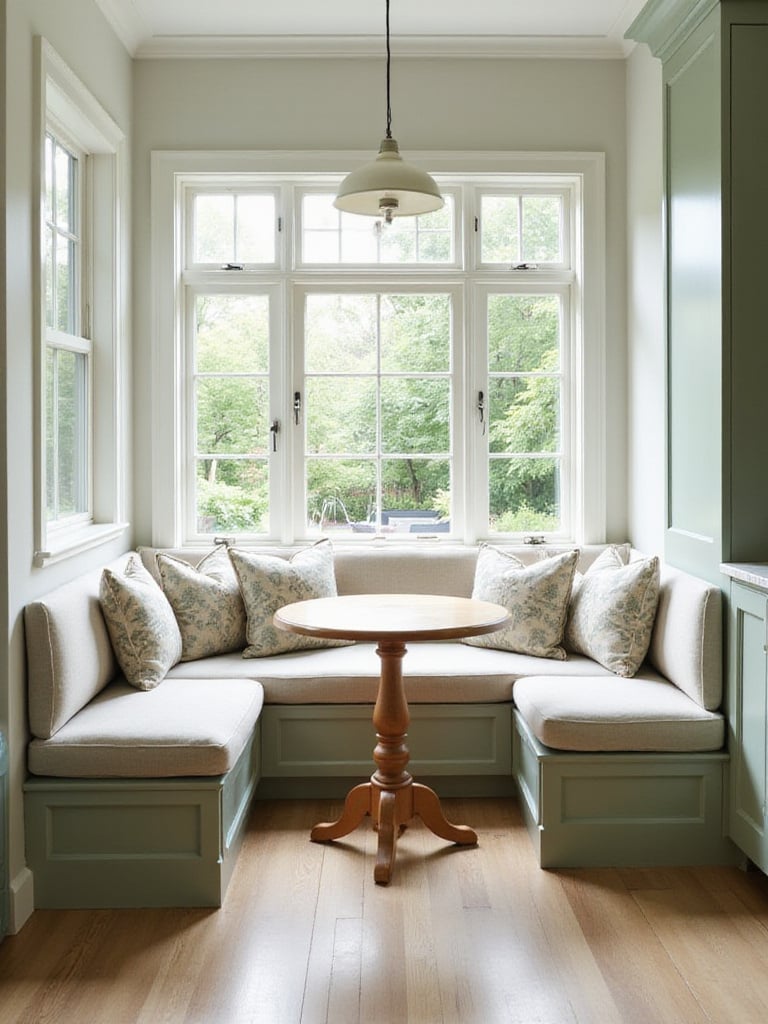
Kitchen seating nooks come in various forms: built-in banquettes (L-shaped, U-shaped, or straight) fitted into corners or along walls; window seat nooks utilizing bay windows or alcoves; freestanding arrangements with small tables paired with benches or chairs; and restaurant-inspired booth-style seating. Your choice depends on available space, desired seating capacity, and aesthetic preference. For maximum functionality, consider incorporating storage drawers underneath seating and ensure adequate table clearance for comfortable movement.
After months of sourcing and curation, I’ve found that these intimate spaces often become the most used areas in the kitchen. A cozy nook is great, but efficient storage is paramount for any kitchen’s functionality and visual appeal.
15. Optimize Storage Solutions
Optimizing kitchen storage creates both functional efficiency and visual harmony. Well-organized storage ensures every item has a designated place, making cooking and cleaning more efficient while reducing counter clutter. Aesthetically, thoughtful storage solutions contribute to a clean, spacious appearance that enhances the overall design and creates a sense of calm order.
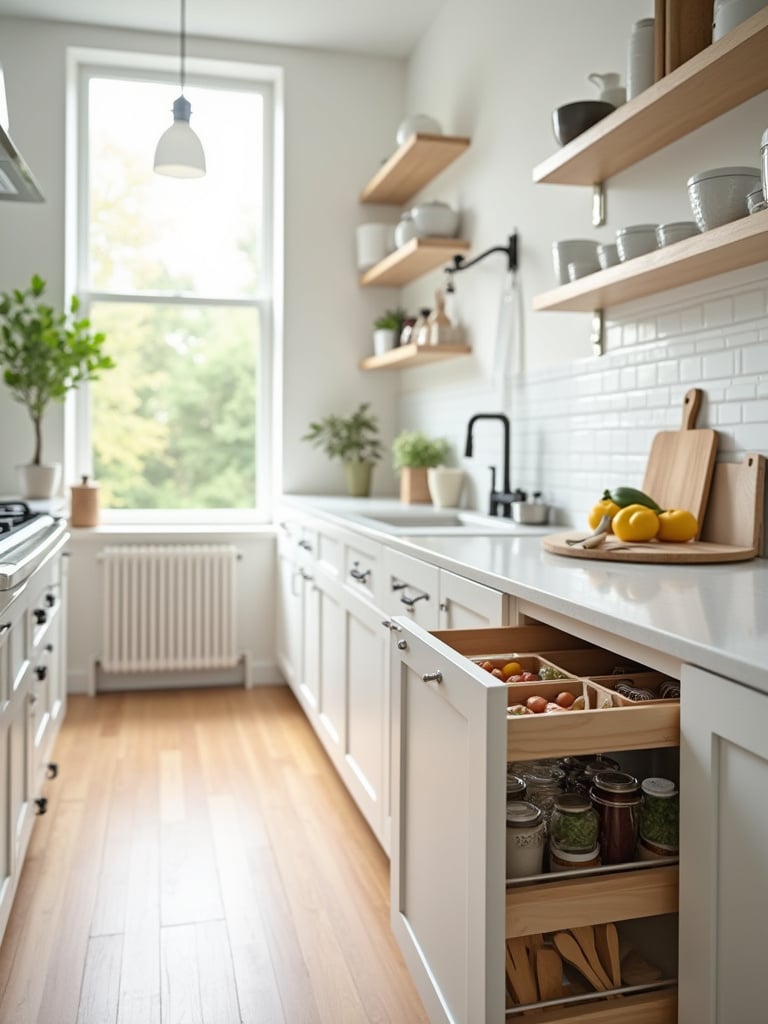
Common kitchen storage challenges include:
- Overflowing Cabinets: Install pull-out shelves or drawers for easier access
- Disorganized Drawers: Use dividers and organizers for cutlery and utensils
- Hard-to-Reach Items: Implement lazy Susans or sliding organizers
- Wasted Vertical Space: Add stackable shelves or vertical dividers
- Lack of Dedicated Storage: Install specific organizers for pots, pans, and appliances
The heritage technique gets a contemporary update through modern storage solutions that honor traditional kitchen organization while embracing new innovations. With storage sorted, let’s turn to the metallic accents that can add sparkle and sophistication to your kitchen decorating inspiration.
16. Mix Metal Finishes
Mixing metal finishes adds depth, visual interest, and personality to your kitchen. This approach moves away from monochromatic or overly matched looks, creating a more layered, sophisticated, and curated space. The contrast prevents the room from appearing flat and helps tie together different design elements or eras within your kitchen.

A good rule of thumb is to limit yourself to two or three different metal finishes to maintain balance without chaos. One metal should typically be dominant (used on major elements like faucets or primary hardware), while others serve as accents (on lighting, smaller hardware, or accessories). Mixing warm tones (brass, gold, copper) with cool tones (chrome, nickel, stainless steel) creates classic contrast, while black or oil-rubbed bronze work as neutral metals that pair well with almost anything. Combining different textures of the same metal—like polished with brushed finishes—adds subtle dimension.
The silhouette draws inspiration from both traditional and contemporary metal applications. While metals add shine, warm wood tones bring an essential element of natural comfort and timeless appeal to kitchen decorating inspiration.
17. Introduce Warm Wood Tones
Warm wood tones instantly add a sense of comfort and natural beauty to kitchens. Unlike cooler materials like stainless steel or stone, wood brings an organic, inviting quality that makes a kitchen feel less sterile and more lived-in. The varied grain patterns and rich colors create visual interest and texture while versatility allows wood to pair beautifully with styles from rustic to modern. It grounds the space and balances industrial elements, making your kitchen feel more welcoming.
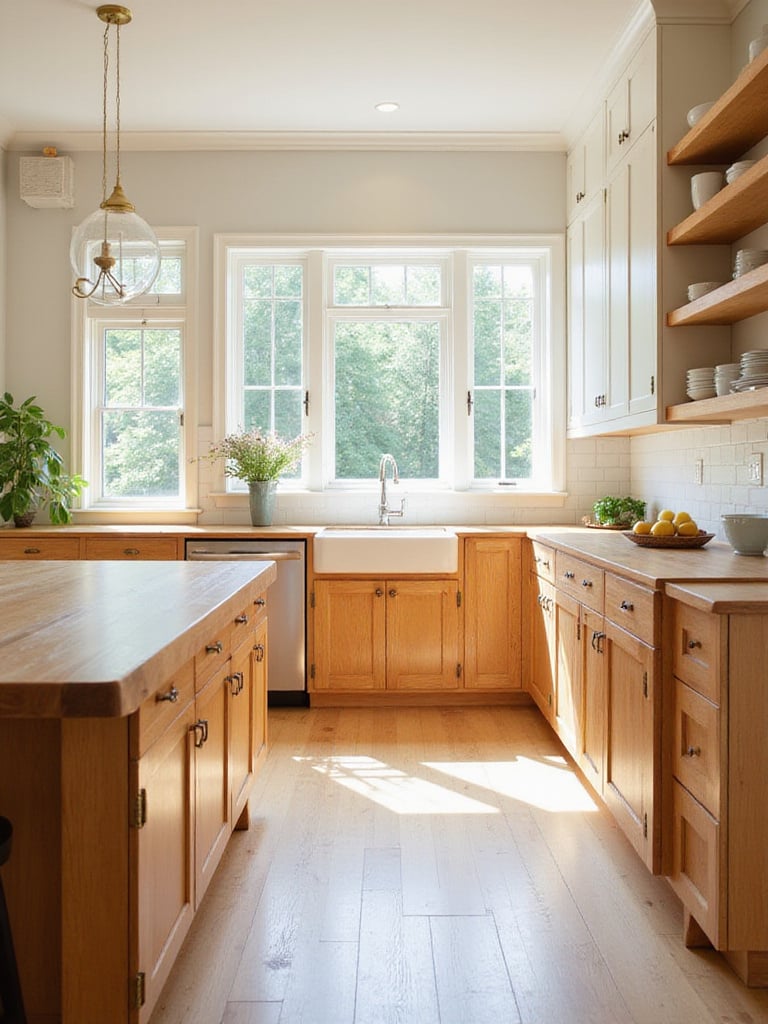
Several wood types offer unique characteristics for kitchens. Oak features a prominent grain pattern and excellent durability in golden or reddish-brown hues. Maple provides a smoother, finer grain with lighter, creamier tones that accept stains well. Cherry wood delivers rich, reddish-brown color that deepens beautifully with age. Walnut offers luxurious deep brown tones with complex grain patterns. Beyond cabinets, incorporate warm wood through open shelving, butcher block countertops, flooring, furniture pieces, ceiling beams, or even smaller accents like cutting boards and bowls.
The material sourcing makes all the difference in how these natural elements enhance your space. Creating dedicated zones, like a coffee or beverage station, adds both functionality and a charming decorative element to kitchen decorating inspiration.
18. Set Up a Coffee or Beverage Station
A dedicated beverage station creates a centralized hub for all your coffee, tea, or other drink needs, streamlining your morning routine and entertaining setup. This organization helps declutter main cooking areas while adding a specific decorative element showcasing your style through curated mugs, containers, and accessories. It makes self-service easier for guests and transforms underutilized spaces into functional, attractive features.
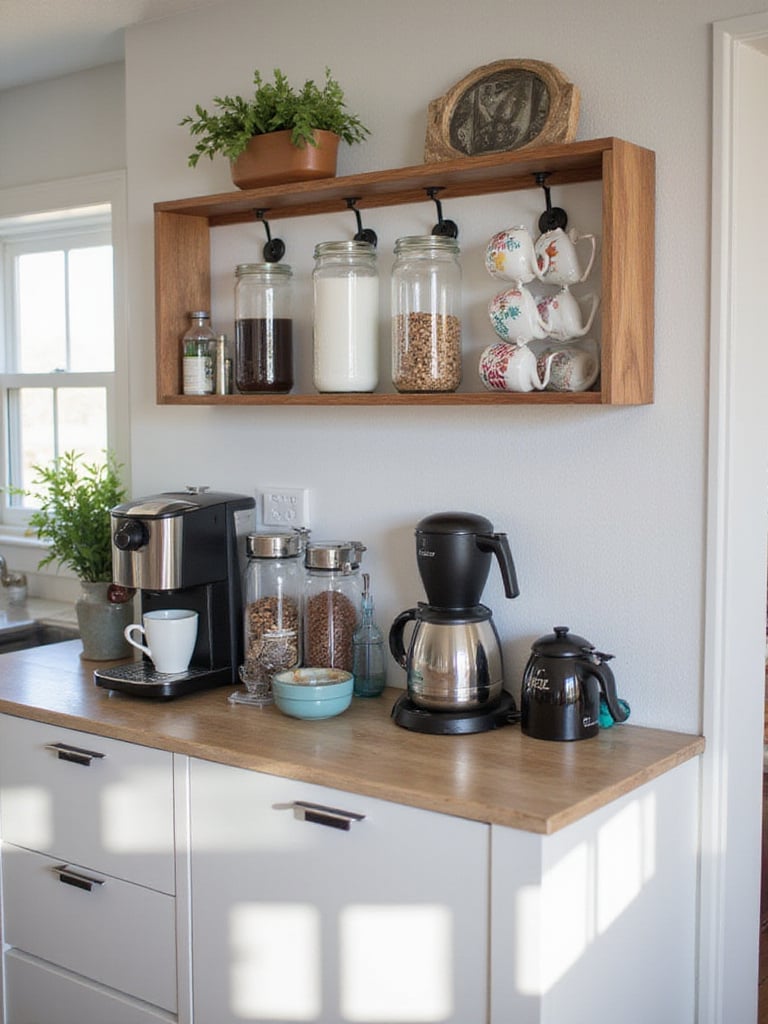
A well-designed station typically includes the primary beverage maker (coffee machine, espresso maker, or kettle), storage for coffee/tea supplies, sweeteners, creamers, and a collection of mugs or cups. Depending on your preferences, you might add flavored syrups, stirrers, filters, napkins, or small snacks. Storage solutions like airtight canisters, tiered organizers, mug hooks, or dedicated drawers keep everything organized, while decorative elements like small plants, artwork, or unique trays complete the look. Ideal locations include unused counter sections, dedicated bar carts, repurposed cabinets, or custom-built nooks.
The discovery of this technique happened when I realized how creating dedicated zones dramatically improves kitchen workflow. For a kitchen with true character, incorporating vintage or antique pieces adds history and unique charm to your kitchen decorating inspiration.
19. Incorporate Vintage or Antique Pieces
Adding vintage or antique items brings immediate character, history, and unique personality to your kitchen. Unlike mass-produced items, these pieces often have a story and showcase craftsmanship from different eras, making your kitchen feel more layered and less sterile. They provide welcome contrast to modern elements, adding warmth and soul while making an environmentally conscious choice by giving new life to pre-loved items.
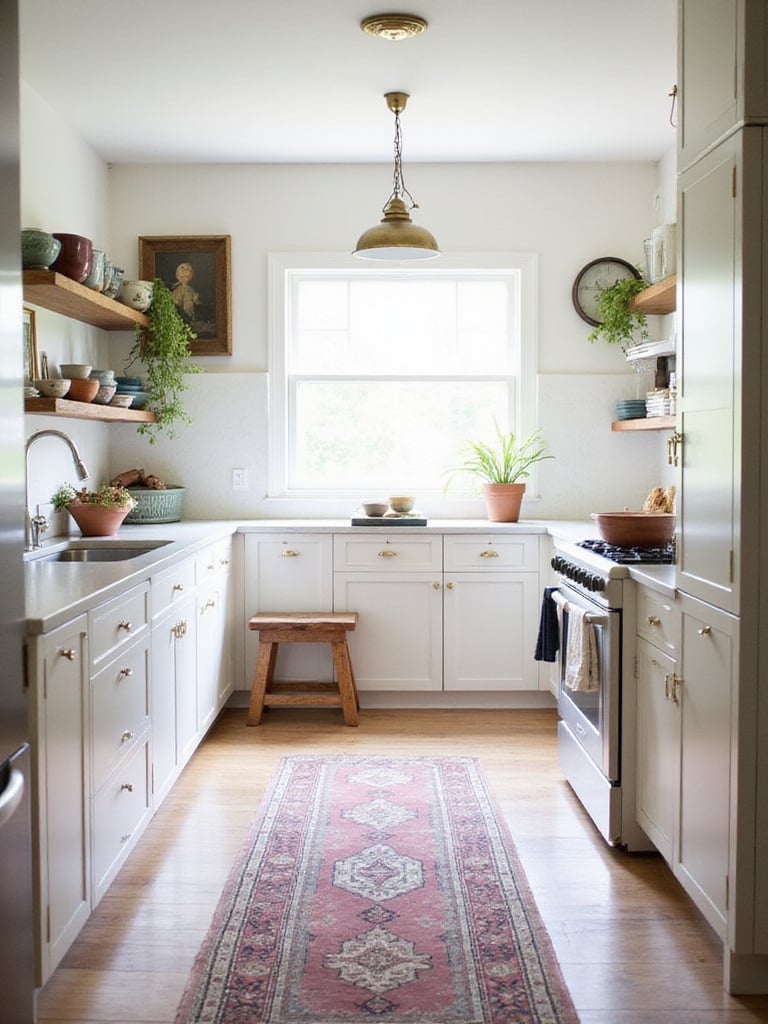
A wide variety of vintage pieces work beautifully in kitchens. Consider functional items like an antique hutch repurposed for storage, a vintage-style rug, or salvaged architectural elements used creatively. Decorative vintage items might include artwork, old scales, antique cutting boards, collections of glassware or ceramics displayed on open shelving, or striking pendant lights. Even a single statement piece—like a beautiful antique dresser converted to an island—can transform your kitchen’s character.
The third-generation workshop where this comes to life continues traditions of craftsmanship that mass production often overlooks. For a playful and practical touch, consider using chalkboard paint in unexpected ways for kitchen decorating inspiration.
20. Use Chalkboard Paint
Chalkboard paint creates a dynamic, writable surface perfect for grocery lists, reminders, recipes, measurement conversions, or family notes. This practical addition helps keep your kitchen organized while reducing paper clutter. Beyond function, it provides a fun, interactive element that encourages creativity and spontaneous expression, making your kitchen more engaging for everyone.
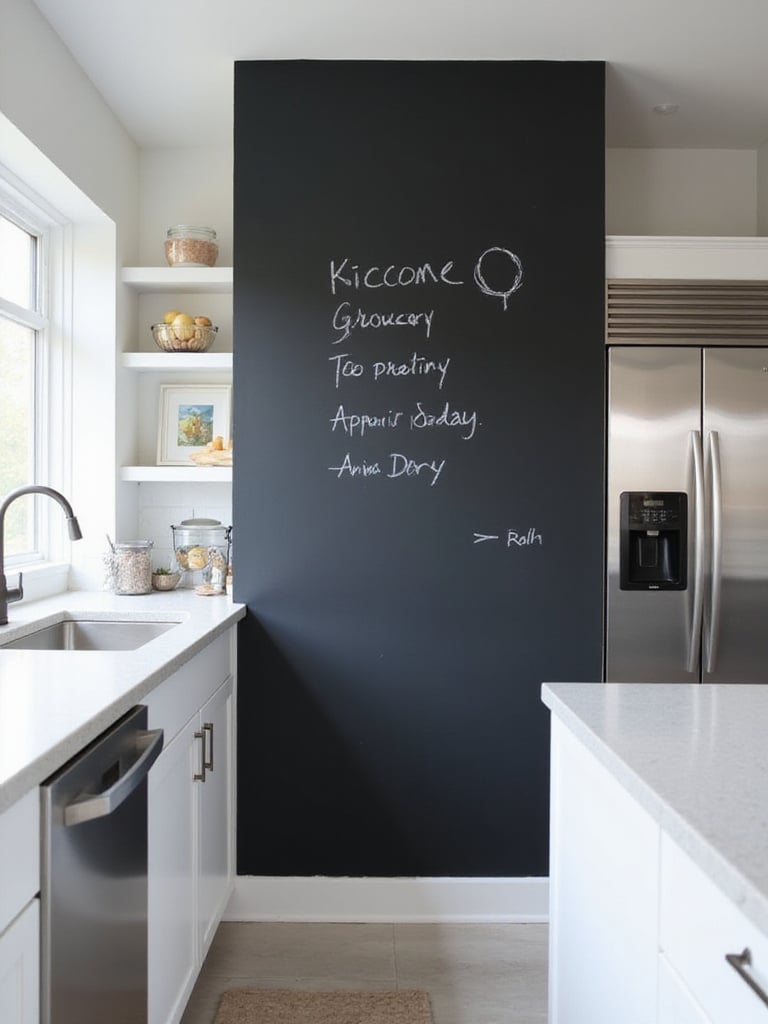
This versatile finish can be applied to various surfaces throughout your kitchen. Popular locations include accent walls for extensive lists or menus, cabinet doors for labeling contents, sections of backsplash for recipes or conversions, inside pantry doors for hidden organization, or even repurposed items like trays or frames for movable message boards. While traditionally black or green, chalkboard paint now comes in numerous colors or can be custom-mixed by adding unsanded grout to any latex paint, allowing it to coordinate perfectly with your kitchen color scheme.
The unexpected benefit comes from how this simple addition encourages communication and creativity in the heart of your home. Instead of hiding everything behind closed doors, displaying certain cookware and dishware can be both practical and decorative in kitchen decorating inspiration.
21. Display Cookware and Dishware
Displaying cookware and dishware serves dual purposes. Practically, it makes frequently used items easily accessible, saving time compared to searching through cabinets. Aesthetically, beautiful pots, pans, dishes, and glassware add color, texture, and personality to your kitchen. They break up cabinet monotony, add rustic charm or modern elegance, and allow you to showcase pieces you love, turning everyday items into decorative elements.
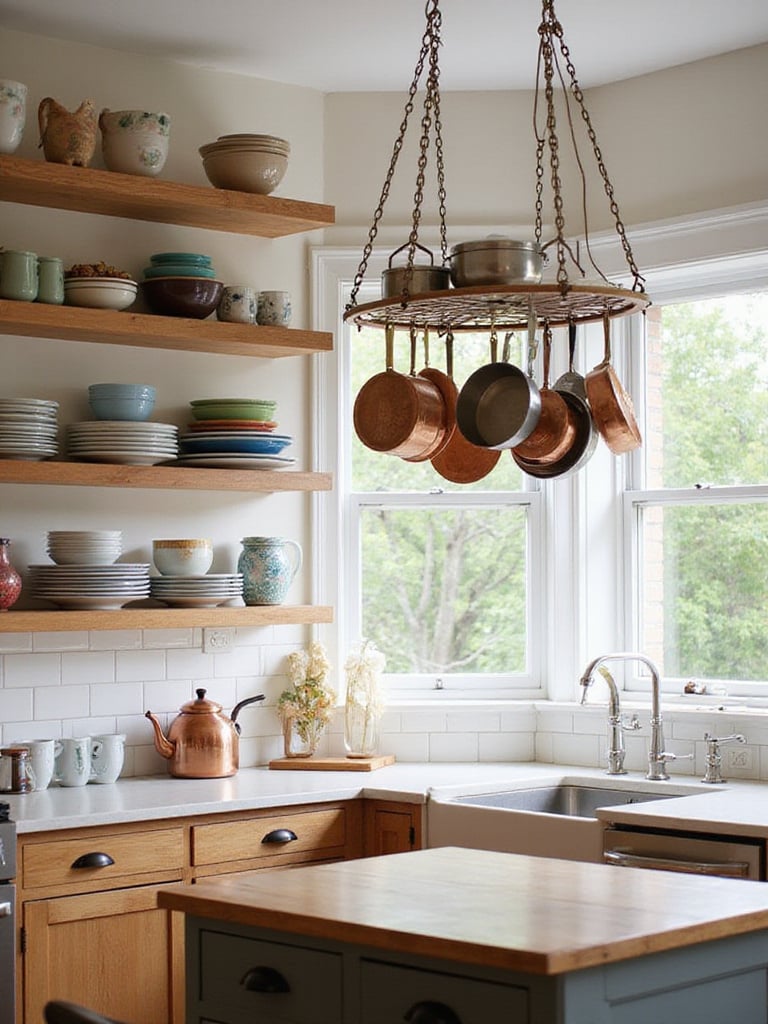
Items best suited for display include those that are visually appealing and in good condition:
- Cookware: Copper pots, colorful enameled cast iron, attractive stainless steel, vintage pieces
- Dishware: Unique dinnerware sets, decorative plates, patterned bowls, fine china, interesting glassware
Ideal display locations include open shelving, pot racks (ceiling or wall-mounted), glass-front cabinets, pegboards for industrial charm, or strategic countertop placement of key pieces. The key is selecting items that enhance rather than detract from your kitchen’s style and color palette.
The design language evolved from traditional patterns that once kept kitchens purely functional to today’s more personalized approaches. If displaying items on shelves isn’t enough of a statement, painting an entire accent wall can dramatically change the room’s feel in your kitchen decorating inspiration.
22. Paint an Accent Wall
An accent wall injects personality, color, and visual interest into your kitchen quickly and affordably. This simple update helps define different zones within the space, such as a dining nook or coffee station, while creating a focal point that makes the room feel more dynamic and intentional. For maximum impact, choose the wall you see first when entering the room or one that naturally serves as a focal point.
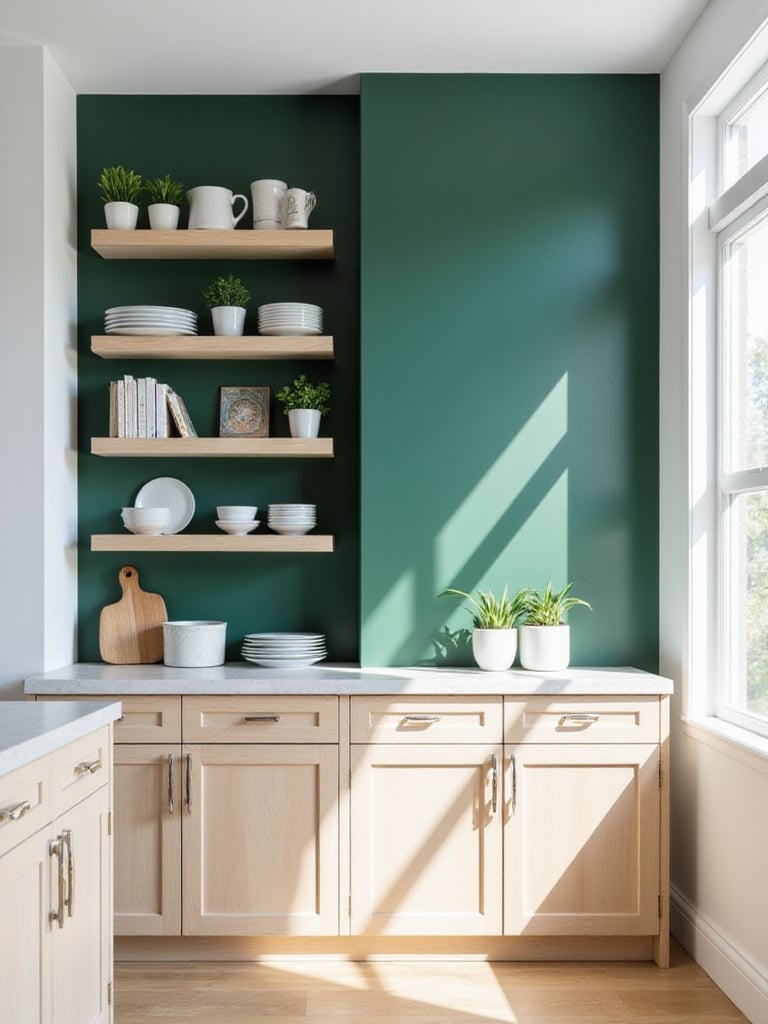
The best accent color depends on your existing kitchen palette and desired mood. Bold colors like deep teal, emerald green, or rich burgundy add drama and energy. For a more subtle effect, consider a darker or lighter shade of your main wall color. In small kitchens, an accent wall is particularly effective—rather than making the space feel smaller (as painting all walls a dark color might), a single accent wall creates depth and draws the eye, making the room feel more stylish without overwhelming it.
The revival of this classic form comes with a twist as today’s accent walls often incorporate texture or specialized finishes. For a truly modern kitchen, integrating smart technology can offer both convenience and a sleek, contemporary look in your kitchen decorating inspiration.
23. Integrate Smart Kitchen Tech
Smart kitchen technology encompasses devices designed to enhance functionality, convenience, and efficiency. This includes major appliances like refrigerators with internal cameras and touchscreens, ovens with remote control capabilities, and dishwashers with optimized cycles. Beyond these, consider smart faucets with touchless control, integrated lighting systems, hidden displays, smart plugs for smaller appliances, and even air quality monitors or leak detectors that blend seamlessly into your decor.

These technologies enhance aesthetics by reducing clutter through integration (hidden screens instead of tablets), offering sleek designs (minimalist induction cooktops, concealed ventilation), and providing dynamic lighting that highlights architectural features. Functionally, they improve workflow through automation, provide information at a glance, enhance safety, and improve efficiency. When planning for smart tech during a renovation, consider infrastructure needs (power outlets, Wi-Fi coverage), ecosystem compatibility, strategic placement, design coordination, and future-proofing options.
Looking closely and you’ll notice the subtle texture of these technologies that blend seamlessly into beautiful design. Finally, make the kitchen truly yours by personalizing it with items that reflect your passions and hobbies in your kitchen decorating inspiration.
24. Personalize with Collections or Hobbies
The kitchen provides a perfect showcase for collections related to food, cooking, or home aesthetics. Suitable items include vintage kitchen gadgets, unique cookbooks, colorful pottery, interesting mugs, curated spice jars, food-themed artwork, or distinctive cutting boards. Even non-culinary collections like travel souvenirs or favorite novels can be thoughtfully integrated, provided they suit the kitchen’s practical environment.

Effective display locations include open shelving, glass-front cabinets, countertop corners, cabinet tops, or wall galleries. To avoid clutter, focus on curation—display only your favorite or most visually appealing pieces grouped by similarity for stronger impact. Use trays or risers to organize smaller collections on countertops, ensure adequate spacing between items, and consider rotating collections seasonally to keep displays fresh while enjoying more of your treasures without overwhelming the space.
The cultural heritage preserved in each piece includes the stories and memories that make your kitchen uniquely yours—the ultimate goal of any kitchen decorating inspiration.
Conclusion
Kitchen decorating inspiration comes from understanding that this space is more than just functional—it’s where life unfolds daily. Each of these 24 ideas offers a different pathway to creating a kitchen that reflects your personality while enhancing how you use the space. From foundational elements like color and lighting to personal touches like displayed collections, the goal is a kitchen that feels authentically yours.
Remember that transformation doesn’t require a complete renovation. Start with smaller changes like updated hardware or styled shelving, then build toward larger projects as budget and time allow. The most successful kitchens balance beauty with practicality, creating spaces that work efficiently while still delighting the senses. By thoughtfully implementing these kitchen decorating inspiration ideas, you’ll create a space that welcomes family and friends while making even everyday cooking feel like a special occasion.

